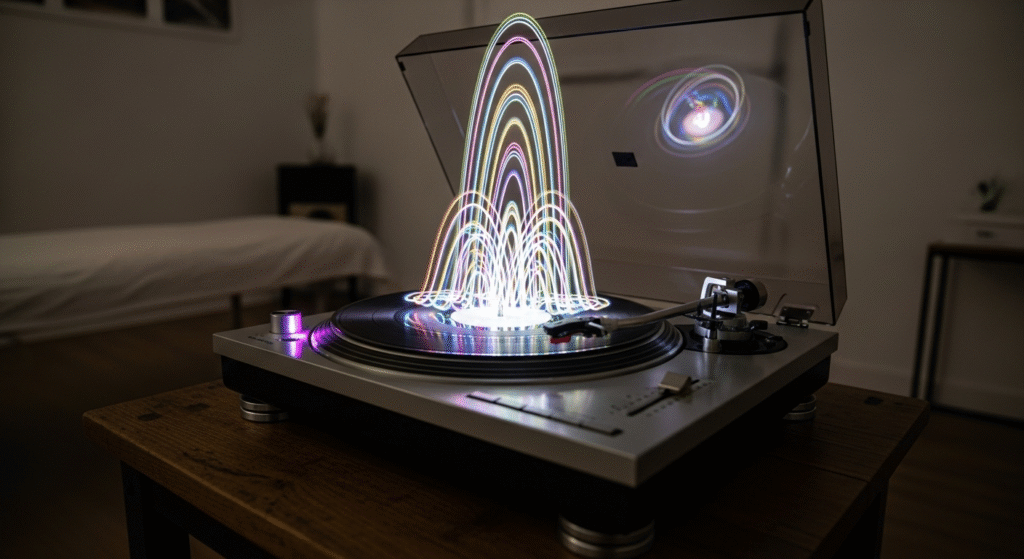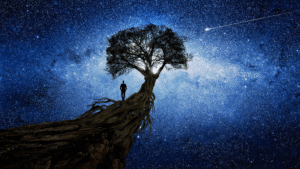In psychedelic-assisted therapy, music isn’t background décor — it’s an active partner in the healing process. When a person enters an expanded state, sound becomes a subtle guide, shaping the emotional terrain, steadying the pace, and inviting meaning. The right music can soften resistance, surface insight, and support release; the wrong music can distract or destabilize. Treating music as a co-facilitator changes the work. It invites us to hold sound with the same reverence and precision we bring to dosage, set, and setting.
Why Are Ícaros Sacred in Traditional Psychedelic Healing?
In many traditional healing lineages, Ícaros are sacred, lineage-held songs used to deepen or steer the experience. They call in the supportive spirits of plants, animals, ancestors, and elemental forces — inviting what no longer serves to lift so that clarity can return. These songs are not performances; they are living medicines. Sung, chanted, or played through instruments, Ícaros carry intentional vibrational frequencies guided by intuition and relationship with the moment, unique to each ceremony and participant.
They are learned through years of apprenticeship and communion with the natural world. Practitioners are entrusted with these songs and share them only when guided to do so. Out of respect for these living traditions, they are not to be copied or performed by those outside the lineage. Some are specific to a particular medicine and belong only to those who have been prepared to carry them. Honoring these roots means resisting imitation. Cultural respect is not merely ethical — it protects the integrity of the healing container.
How Do You Curate the Right Music for Psychedelic Therapy?
In clinical and community settings in the North, many facilitators are not trained to sing traditional Ícaros — and that’s okay. Today, a growing body of carefully composed music exists to support inner journeys. The facilitator’s role becomes one of curation: assembling a sonic journey that serves the person before you. Combining intuition, empathy, and intention, you create a playlist that becomes a form of nonverbal guidance.
Personalizing this curation with care is key. What moves you — to joy, grief, curiosity, or even discomfort — can evoke similar depths in the client. Sometimes, the music that stirs resistance is what opens the door to release. That said, sensitivity matters. If certain cultural or religious tones may be triggering, discuss this in advance.
A useful approach is to design the playlist in six arcs that mirror the medicine’s journey:
1. Grounding – orienting and preparing the nervous system
2. Opening – gently expanding awareness
3. Depth/Processing – moving into the emotional terrain
4. Cathartic Peak – allowing full expression and release
5. Returning – softening, integrating, and coming back
6. Landing – grounding and restabilizing
Because vocals can easily steer meaning, many facilitators favor instrumental or non-lexical tracks during the most intense phases. Avoiding lyrics in the client’s native language can prevent over-association and keep the focus inward.
Informed consent should include discussion about the role of music — its diversity, intensity, and cultural range — and an invitation to stay curious about whatever it evokes. You might even let clients sample portions of the playlist beforehand, asking what imagery or emotions arise. This exercise can help them experience how sound acts as a bridge to their inner landscape.
What Does Music Actually Do to the Brain During Psychedelic Experiences?
Research shows that psychedelics temporarily loosen the brain’s usual patterns of connectivity, creating a more flexible, receptive state. In this openness, music acts like a guide rope — it helps the mind make sense of unfolding sensations, shapes emotional flow, and supports new connections that can integrate into lasting insight (Carhart-Harris et al., 2016).
Bill Richards of Johns Hopkins describes music as a nonverbal support system, “like the net for a trapeze artist. If all is going well, you’re not even aware it’s there — but if you start getting anxious, it’s immediately there to provide structure.”
The Invitation
Music is a bridge — between body and memory, feeling and insight, the individual and something larger. Whether you are singing a lineage-held Ícaro or curating a playlist for a clinical session, your intention is the heart of it. Choose with care. Let compassion lead. Trust your attunement more than any fixed formula.
When we treat music as part of the medicine, we create spaces where people can safely release what no longer serves, recover clarity, and carry the experience forward with steadier hearts. In this way, music does more than accompany healing — it becomes the current that carries it.
If you’re curious to explore these principles more deeply — whether you’re a practitioner refining your approach or simply drawn to understand how sound shapes healing — join us for a free webinar Sound & Psyche: The Healing Power of Music in Psychedelic Therapy on October 23rd. This webinar will bring together experienced voices in the field to discuss practical approaches to music curation, the neuroscience behind sonic guidance, and the ethical considerations that ground this work.
References:
Barrett FS, Preller KH, Kaelen M. Psychedelics and music: neuroscience and therapeutic implications. Int Rev Psychiatry. 2018 Aug;30(4):350-362. doi: 10.1080/09540261.2018.1484342. Epub 2018 Sep 21. PMID: 30240282.
Carhart-Harris RL, Muthukumaraswamy S, Roseman L, Kaelen M, Droog W, Murphy K, Tagliazucchi E, Schenberg EE, Nest T, Orban C, Leech R, Williams LT, Williams TM, Bolstridge
M, Sessa B, McGonigle J, Sereno MI, Nichols D, Hellyer PJ, Hobden P, Evans J, Singh KD, Wise RG, Curran HV, Feilding A, Nutt DJ. Neural correlates of the LSD experience revealed by multimodal neuroimaging. Proc Natl Acad Sci U S A. 2016 Apr 26;113(17):4853-8. doi: 10.1073/pnas.1518377113. Epub 2016 Apr 11. PMID: 27071089; PMCID: PMC4855588.
© 2023 American Psychedelic Practitioners Association and BrainFutures – First Edition, August 2023
Kaelen M, Roseman L, Kahan J, Santos-Ribeiro A, Orban C, Lorenz R, Barrett FS, Bolstridge M, Williams T, Williams L, Wall MB, Feilding A, Muthukumaraswamy S, Nutt DJ, Carhart-Harris R. LSD modulates music-induced imagery via changes in parahippocampal connectivity. Eur Neuropsychopharmacol. 2016 Jul;26(7):1099-109. doi: 10.1016/j.euroneuro.2016.03.018. Epub 2016 Apr 12. PMID: 27084302.
Richards, W. A., Sacred Knowledge: Psychedelics and religious Experiences https://doi.org/10.7312/columbia/9780231174060.001.0001



